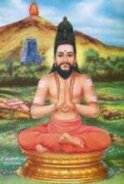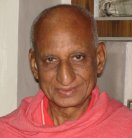

THE ESOTERIC
KANDAR ANUBHUTI
OR
THE SECRET TEACHING ON
GOD-EXPERIENCE
(A Treatise on Adwaitic Realization)
OF
SAINT ARUNAGIRINATHAR

 |  THE ESOTERIC KANDAR ANUBHUTI OR THE SECRET TEACHING ON GOD-EXPERIENCE (A Treatise on Adwaitic Realization) OF SAINT ARUNAGIRINATHAR |  |
 | by N.V. Karthikeyan |  |
| verses contents 17 18 19 20 21 22 23 24 25 26 .. 32 this verse in PDF version (4 parts) p-1 p-2 p-3 p-4 complete download of this book |
VERSE-22 காளைக் குமரேசன் எனக் கருதித் தாளைப் பணியத் தவம் எய்தியவா பாளைக்குழல் வள்ளிபதம் பணியும் வேளைச் சுரபூபதி மேருவையே.Kaalaik kumaresan enak karuthit, Thaalaip paniyat thavam eaithiyavaa Paalaik kuzhal valli patham paniyum, Velai sura-bhoopathi meruvaiye. To 'feel' Satchidananda, -- O Lord, the Great, -- Commentary This verse has deep esoteric meaning far beyond the apparent one. To think that the Lord is Youthful and Powerful while bowing to His Feet, as the verse is usually interpreted, does not demand great Tapas or austerity, as even a beginner in Sadhana or any ordinary devotee can do this. But to think and feel Satchidananda (undivided, all-pervading, homogeneous Consciousness-Bliss) and bow to His Feet demands dedicated and prolonged practice which is called 'Tapas' (தவம்). It is an advanced stage of meditation that comes after a long period of practice coupled with Guru's/God's grace. காளைக் குமரேசன் -- 'Kaalaik Kumaresan' has a mystical and esoteric meaning. 'Kaalai' means Eternal Youth, which means Eternal Existence or Sat. 'Kumaran' means the destroyer of evils, the world-delusion or Maya, and it refers to Knowledge or Chit. 'Isan' means the Over-lord of everything, Supreme Power which implies Supreme Happiness or Ananda. Thus 'Kaalaik Kumaresan' means Sat-chit-ananda. We have seen earlier (in the intro) about the Incarnation or Avatara of Lord Skanda, that It is the Mass of Infinite Consciousness (Jyoti Pizhambu -- சோதிப் பிழம்பு) -- that condensed Itself into a form and appeared as Murugan. To be able to 'feel' this while bowing to the Lord is not easy. Thousands and thousands of devotees bow to the Lord daily in temples and at homes; how many of them are able to 'feel' that they are bowing to the Satchidananda Mass? The seeker continued that intense meditation and prayer of the previous verse for a long period of time, which is a great Tapas or austerity. It has earned him the special merit by which when he bows to the Feet (of the Lord) he could also think and feel that the Lord is all-pervading, a mass of Satchidananda (Existence-Knowledge-Bliss Absolute). It is not an easy achievement. He wonders how he could reach such a high state! Of course, it is a way of acknowledgment of the Guru's and Lord's grace. The ability to feel Satchidananda behind the form of the Lord/Guru may be regarded as the first stage of the practice of 'Poomel mayal pooy arameippunarveer' -- to behold Satchidananda behind Naama-rupa or names and forms. Later he will be able to feel Satchidananda behind all names and forms (nama-rupa prapancha). The initiation of the Guru (verse 20) has given the disciple the proper technique of meditation on the Lord. Now, when he commenced his meditation with this technique and with a true longing to attain liberation (verse 21), due to the immediate impact of the Guru's initiation and the power transmitted by him, the aspirant is very successful in his meditation. When he continued the practice for some time, he is able to feel the Absolute (Satchidananda) that is behind the form that he worships or meditates upon. This gives him great joy and makes him exclaim the infinite grace of the Lord. But this experience does not last long, as Avidya will get stirred up and start playing its mischief, which we will see in the subsequent verses. "To think and feel Satchidananda while bowing to the Lord's Feet," -- In this experience both Jnana (feeling Satchidananda) and Bhakti (bowing to Lord) get blended. Hence, it is regarded as a great Tapas and meritorious achievement. Mount Meru is said to be the greatest mountain on earth. One cannot imagine its length or breadth, or its greatness. It is regarded as the axis of this earth. So is the Lord, beyond human understanding and description, the support of all. When we bow to the Lord, we should think of Him not in terms of a name and form, but as Satchidananda. Our body should bow to the image or even the picture of the Lord, but the mind should be fixed on the Infinite. What-ever be (the name of) the Lord - Siva, Vishnu, Rama, Krishna, Skanda, Vinayaka, Devi, Christ, etc. - they are essentially the same - Satchidananda, just as whatever be the name and shape of the ornament, the substance is only gold. This fact we have to bear in mind when we think of Him or meditate on Him or bow to Him. It is a great blessing. 'Thinking of Him as Satchidananda and bowing to His Feet' may be said to refer, respectively, to the Svarupa-lakshana and Tatastha-lakshana of God. To bow to the Feet means we take the Lord in His manifested form - whatever the form be - which is the Tatastha-lakshana. It is the relativistic aspect of God, of manifestation or Avatara, for a purpose. It is not that the Lord cannot take that form again or appear again in that form to give Darshan to His devotees. He can. But it is not His essential nature or Svarupa-lakshana. Satchidananda or the Absolute unconditioned existence-knowledge-bliss is the Svarupa-lakshana of God. While the Tatastha-lakshana differs with every manifestation, the Svarupa-lakshana is the same for all. Hence, to bow to any form of God fixing one's mind on the Svarupa-lakshana is indeed a state of special blessedness obtained purely by long practice and Lord's grace, because while the Tatastha-lakshana can be understood by the human mind, Svarupa-lakshana can be felt or experienced in the heart only when revealed by the Lord out of His grace. The idea is that our prayer, worship, meditation, etc. should not merely end with Tatastha-lakshana. The purpose of all these spiritual practices is to attain the Svarupa-lakshana. The former goes by the name of 'popular religion' which is practised by the vast majority of people, according to each one's religious faith and custom. It, therefore, differs from religion to religion. But the latter belongs to 'mystic religion' - to saints and sages, whether of this religion or that religion, whose experiences are the same whether they be of the East or West, ancient or modern. There is no difference of experience or opinion among them. The religious quarrels and dogmatic bigotry arise only among the popular religions. Then, are we to dispense with the popular religion or the different methods of worship of God? No, it is not necessary, not also desirable. It provides the initial background for the neophyte to hold his mind on to something, from where he has to go higher. The different religions and religious practices are, therefore, not to be rejected but included and transcended into the mystic religion, even as the college education does not reject, but includes and transcends what has been learnt in the high school. Because there are colleges, we do not dispense with elementary and high schools, for the latter provide the needed basic education without which the higher college education would be impossible. So is the case with the popular religions. Again, all cannot afford to go to college. But yet an high school educated man is better than an illiterate. So also, though all cannot easily attain the mystic vision of God, a man of the popular religion is better than a worldly man or non-believer, for whom there is nothing beyond the world. The latter will indulge in all lawlessness and sin, while the former will have fear of God and regard for the moral and spiritual values of life. But we should not stop with it. We should at least know that there is something higher than the popular religion which is only a pointer to the Higher. The popular religion has to lead to the mystic religion and not to religious bigotry. The Tatastha-lakshana and Svarupa-lakshana are both of God, the former to lead to the latter. 'Thinking of You as Satchidananda, one should bow to Your Feet': Thinking is an inner attitude and bowing is an external act. The right Bhava (attitude) should follow an action, is implied by this. To feel the Omnipresence of the Lord while we bow to His Feet is indicated here. If the right attitude is not there, mere external action becomes meaningless and often hypocritical. And here it is that religions and religious ceremonies, nay even the secular actions of an individual, become lifeless in spite of their external pomp and grandeur. But a doubt may arise: Is it necessary for saints and holy men who can feel the Omnipresence of God to continue performing the external act of bowing to the Lord, or offer worship, etc.? Yes, it is necessary. Though God looks to their hearts and their inner attitude alone, yet the external action is to be performed by them because people cannot see or understand their inner attitude but can only see their actions, which they take as a mode of conduct for them to follow. People follow what the great ones or saints do. Hence, if a saint keeps quiet, only maintaining his inner feeling of the Omnipresence of God, which people cannot perceive, they will also not do any worship or prayer; nor can they entertain the proper Bhava in their heart. Thus, bereft of both the inner feeling and outer practices they will be totally lost. Hence, saints and holy men continue to perform external acts of worship, etc, for the sake of others to emulate. When people follow them and perform worship, bowing to the Lord, etc., they will get the proper inner attitude in course of time, by the Lord's grace. What a profound verse! Arunagirinathar packs so much of wisdom into a few words. |
| contents 17 18 19 20 21 22 23 24 25 26 .. 32 this verse in PDF version (4 parts) p-1 p-2 p-3 p-4 |
| ... www.kaumaram.com ... The website for Lord Murugan and His Devotees முகப்பு கௌமாரம் அட்டவணை மேலே தேடல் home Kaumaram contents top search |
Kaumaram.com is a non-commercial website. This website is a dedication of Love for Lord Murugan. Please take note that Kaumaram.com DOES NOT solicit any funding, DIRECTLY or INDIRECTLY. |